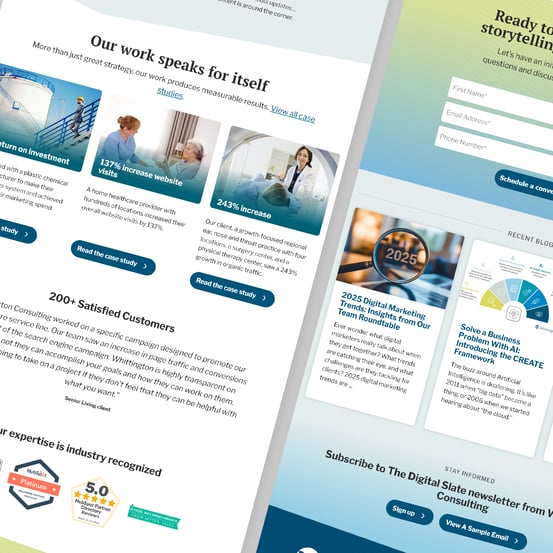As the marketing director at your company, you know your website is a critical asset. But is its content pulling its weight? To truly succeed online, your website content needs to do three things exceptionally well:
- Attract qualified traffic through search engines (SEO)
- Engage visitors and guide them towards action (conversions)
- Be effortless to read and understand (readability)
This guide will help you achieve all three. We'll move beyond basic tips and cover a comprehensive strategy for crafting website content that not only ranks higher but also resonates deeply with your target audience, ultimately driving business growth.
Industry research highlights that great website content must be relevant, valuable, and keyword-optimized. Well-structured, user-focused content doesn't just please search engines, it keeps visitors engaged longer.
This post will serve as your definitive guide to transforming your website copy into a powerful engine for attracting qualified traffic and generating valuable leads. We'll provide actionable tactics to help you create content that ranks, reads well, and converts.
Summary
A Guide to Writing Your Copy To Attract Qualified Traffic and Generate Valuable Leads
- Why Great Website Content Matters
- Understand Your Audience and Set Your Content Goals
- Keyword Research and SEO Strategy
- On-Page SEO Best Practices
- Structure Your Content for Readability
- Write in a Clear, Trustworthy Style
- Determine the Right Content Length (Depth vs. Brevity)
- Include Strong Calls-to-Action (CTAs)
- Building Content that Ranks and Converts
Why Great Website Content Matters
Before getting into the "how," let's solidify the "why." Today’s B2B business is more digital than ever, and your prospects are doing their own research before talking to your sales team.
- Forrester Research indicates that B2B buyers might be anywhere from 67% to as much as 90% of the way through their buying journey before they engage a vendor's salesperson.
- Research from Gartner has consistently highlighted this trend. They've reported that B2B buyers spend only 17% of their total purchase journey time meeting with potential suppliers. When comparing multiple suppliers, they might only spend 5% or 6% of their time with any one sales rep. The vast majority of their time is spent researching independently online (45%) or offline.

This means that your buyer has often identified their problem or need.
They've researched potential solutions online. They may have started defining their specific requirements. They've likely identified potential vendors through web searches, review sites, social media, and content marketing. They may have already compared features, read reviews, looked at case studies, and formed initial opinions or even a shortlist.
Because so much research today is done online, high-quality website content is the cornerstone of effective digital marketing. It has to balance SEO requirements, AI search requirements, and the needs of human readers to achieve tangible business outcomes.
Over one-third of your website visitors will disengage from a website if the content or layout is unattractive.
That's a significant portion of potential leads lost simply due to subpar presentation or substance. Here’s how quality content impacts your key metrics:
SEO Rankings
Search engines like Google prioritize content that satisfies user intent, meaning it directly answers the searcher's query. High-quality, readable content earns longer dwell times (visitors stay longer) and lower bounce rates (visitors explore more), signaling to Google that your page is valuable, thus boosting rankings.
AI Search Visibility
As AI search starts to take share from search engines, your company’s brand visibility depends on properly optimizing your website content to be included. One of our manufacturing clients received more deals from AI search than ThomasNet in Q1 of 2025.
User Engagement
Clear, engaging content captures attention immediately and keeps readers interested. This builds trust and encourages them to explore further.
Conversions
Ultimately, website content should guide visitors toward a desired action. Content that builds trust, addresses pain points, and clearly presents value propositions is far more likely to convert visitors into leads or customers.
Understand Your Audience and Set Your Content Goals
Effective website content begins long before you type the first word. It starts with deeply understanding who you're talking to and what you want them to achieve. Top guides consistently emphasize "know your audience" as the foundational rule.

Identify Your Ideal Customer
For you, as a marketing manager, this means getting specific about your ideal customer:
- What are their biggest challenges and pain points related to your industry?
- What questions are they asking at different stages of the buyer's journey (awareness, consideration, decision)?
- What is their level of expertise? What language do they use?
- What motivates them? What are their goals?
Imagine a specific prospect. What information do they need to see on your website to feel understood and find solutions? Your content must address these needs directly and empathetically.
If you haven’t defined your ideal customer profile on paper, I’d invite you to use our free custom AI for documenting your ideal customer profile.
Define the Purpose of Each Page/Post
Not every page has the same goal. Before writing, clarify the primary conversion goal for each page or specific piece of content:
- Is it to generate a lead (e.g., "Request a Quote," "Download Guide")?
- Is it to educate and build trust (e.g., informative blog post, case study)?
- Is it to drive engagement (e.g., "Sign up for Newsletter," "Register for Webinar")?
- Is it to directly support a sale (e.g., product/service page)?
Clarity on the desired outcome dictates the content's focus, tone, and call-to-action.
Keyword Research and SEO Strategy
To attract organic traffic, your content needs to align with what your potential customers are searching for. This requires strategic keyword research.

Find Topics Your Audience Searches
Start by brainstorming terms related to your products, services, and the problems you solve. Then, use tools to validate and expand your list:
- Google Keyword Planner: Identifies keyword volume and suggests related terms.
- Semrush or Ahrefs: Powerful SEO suites for keyword research, competitor analysis, and topic discovery.
- AnswerThePublic: Visualizes questions, prepositions, and comparisons people search for around a keyword.
Look for a mix of:
- High-volume keywords: Broad terms with significant search traffic (e.g., "financial software").
- Long-tail keywords: More specific phrases, often questions, with lower volume but higher intent (e.g., "how to install financial software on a Mac").
If keyword research sounds too technical for you, we’d invite you to use our custom AI application that identifies common questions your ideal customer profile is likely to ask. Then you can use these questions to build your content library.
Choose Primary and Secondary Keywords
For each page, select:
- One primary keyword: The main topic focus.
- A few secondary keywords: Related terms or synonyms that support the primary topic.
This focus helps search engines understand the page's core subject.
Map Keywords to Content Topics & User Intent
Consider the user intent behind the keywords. Are searchers looking for:
- Informational content: Seeking answers or learning about a topic (e.g., "what is rotomolding?").
- Navigational content: Looking for a specific website or brand (e.g., "Whittington Consulting blog").
- Commercial investigation: Comparing options or researching solutions (e.g., "best CRM for midsized companies").
- Transactional content: Ready to buy or take a specific action (e.g., "buy plastic resin wholesale").
Your content type should match the searcher's intent. An informational blog post won't satisfy a transactional search, and vice versa. Remember, keywords matter for signaling relevance to both search engines and users. Focus your writing efforts on naturally integrating keywords in text.
On-Page SEO Best Practices
Once you have your topic, audience, goals, and keywords, it's time to optimize the content itself. Here’s a checklist:

Craft SEO-Friendly Title Tags & Meta Descriptions
Page title (meta title tag)
This is the blue clickable link in search results.
- Include your primary keyword, preferably near the beginning.
- Make it compelling and clear about the page's content.
- Keep it around 50-60 characters (the actual title of the page can be longer, but shorten the meta title tag to 50-60 characters).
- Example: "Writing Website Content for SEO & Conversions |- Whittington Consulting" (Good) vs. "Content Tips" (Not optimized).
Meta description
The short snippet under the title in search results.
- Doesn't directly impact rankings, but influences click-through rate.
- Summarize the page's value proposition and include the primary keyword naturally.
- Include a subtle call-to-action or highlight a key benefit.
- Keep it around 155 characters.
- Example: "Learn how to write website content that ranks, converts & engages. Our complete guide covers keywords, readability, CTAs & more for marketing managers."
Optimizing meta titles and descriptions over time
One less common approach to getting more website traffic from search engines is analyzing Google Search Console for optimization opportunities. Once your website is submitted to Google Search Console, you can learn click-through rates from search engine results. We find that feeding this impression and click data to AI and prioritizing optimization opportunities has helped clients steadily improve website traffic.
Use Headings and Subheadings Effectively
- Structure your content logically using HTML heading tags (H1, H2, H3, etc.).
- Use only one H1 tag per page – this should be your main page title.
- Use H2s for main sections and H3s for sub-points within those sections.
- Incorporate primary and secondary keywords naturally within some headings.
- Headings help search engines understand content hierarchy and make the page easily scannable for readers.
Internal and External Linking
- Internal links: Link to other relevant pages or blog posts on your own website using descriptive anchor text (the clickable words). This helps distribute SEO authority, keeps readers engaged longer, and guides them through your site. Avoid over-optimizing anchor text with the exact keyword every time.
- External links: Link out to relevant, authoritative external sources to back up claims or provide additional context. This can improve credibility and may be seen positively by Google.
Image Optimization
While optimizing text is the focus of this blog post, images enhance readability and engagement. If using images:
- Use descriptive file names (e.g., writing-website-content-tips.jpg instead of IMG_1234.jpg).
- Properly size and compress images to improve web page performance.
- Write descriptive alt text (alternative text) for each image, incorporating relevant keywords naturally. Alt text helps search engines understand image context and improves accessibility.
Optimize for Mobile Reading
Google uses mobile-first indexing, meaning it primarily looks at the mobile version of your site for ranking. Ensure your content is easily readable on smaller screens:
- Use a responsive website design that adapts to different screen sizes.
- Use legible font sizes.
- Use high-contrast colors to ensure readability.
- Ensure adequate spacing between elements.
- Optimize images to load quickly.
Technical factors like mobile-friendliness and page speed are crucial for user experience and SEO. If someone on your team isn’t technologically inclined, it can be helpful to have a savvy person or team review your website quarterly to fix things.
Structure Your Content for Readability
People rarely read web pages word-for-word. Studies show 79% of users scan rather than read (Nielsen Norman Group). Making your content easy to scan and digest is critical for keeping readers engaged and reducing bounce rates – key indirect SEO signals.

Hook Readers with a Strong Introduction
You have mere seconds to capture attention. Your opening lines must:
- Clearly state the topic and its relevance to the reader.
- Highlight a key benefit or address a pressing pain point.
- Pose an intriguing question or share a surprising fact.
- Lead smoothly into the main content.
This is why it’s important to keep your web page content focused on your prospective customer’s needs and not bragging about your company.
Apply the Inverted Pyramid Model
This classic journalistic structure works wonders online. This caters to impatient readers and ensures your core message gets across quickly.
Put the most crucial information first.
Summarize key takeaways or conclusions at the beginning.
Elaborate with details, examples, and supporting information.
Use Short Paragraphs and Sentences
Avoid daunting "walls of text."
- Keep paragraphs short: 2-4 sentences maximum is a good guideline.
- Aim for sentence lengths under 20-25 words where possible. Sentences should ideally be 35 words or fewer.
- Use simple, familiar language. If your company works in several industries, it might be best to create pages for each industry so you can use their vernacular in your website copy.
- Aim for a 7th-9th grade reading level for general business audiences.
Remember the 8-second attention span rule – get your message across clearly and quickly. Be concise; less is often more.
That’s not to say you should keep pages short. If people are reading your website for informational purposes or even for transactional purposes, being detailed and descriptive proves your expertise and can help advance the sale.
Incorporate Images or Media (When Possible)
Relevant images, infographics, charts, or even short videos can break up text, illustrate complex points, and boost engagement. Ensure any media is optimized for web use and properly tagged for SEO. Even if you cannot embed images now, structuring your text to potentially accommodate visuals later is wise.
Write in a Clear, Trustworthy Style
Beyond structure and optimization, the way you write significantly impacts engagement and credibility. While your company likely has style and tone guidelines for public-facing writing, it’s best to consider the following for your website.

Use a Conversational, Active Tone
- Write as if you're speaking directly to the reader. Use "you" and "your."
- Use active voice whenever possible. It's more direct, concise, and engaging than passive voice.
- Active: "Our guide will help you improve your website copy."
- Passive: "Website copy will be improved by following this guide."
- Aim for a professional yet approachable tone that fits your brand.
Avoid Jargon and Complex Words
Unless your audience consists solely of technical experts, nix the jargon.
- Use plain language your target reader understands and uses daily.
- If industry terms are necessary, explain them simply.
- Overly complex language can confuse and alienate readers
- Focus on clarity. Use readability tools (like Hemingway or built-in checkers) to aim for around an 8th-grade reading level (Flesch-Kincaid Grade Level ~8). While Google doesn't rank based on reading level, content that's too difficult for your audience will hurt engagement and, indirectly, SEO.
Show Credibility (E-A-T) & Show, Don't Tell
Demonstrate E-A-T (Expertise, Authoritativeness, Trustworthiness):
Google values this, especially for important topics. Build trust by:
- Including author names and brief bios. (You’ll notice an "About the Author" section here on our blog, which is good practice.
- Citing reputable sources for data and claims.
- Ensuring content is accurate, well-edited, and up-to-date.
Show, don't tell
Instead of making vague claims, provide specific examples or data.
- Telling: "Our product is high quality."
- Showing: "Our product uses aircraft-grade aluminum, passes rigorous stress tests, and comes with a 5-year warranty, ensuring durability." This also naturally adds relevant keywords and depth. Use mini-case studies or before/after examples where applicable.
Maintain a Consistent Brand Voice
Ensure your writing style is consistent across all website pages and marketing materials. This builds brand recognition and trust. Establishing simple brand voice guidelines can help ensure cohesion, whether writing a blog post, service-focused page, or a landing page.
Determine the Right Content Length (Depth vs. Brevity)
A common question is: "How long should my web content be?" As one of our blog posts states, there's absolutely no magic word count.
Length should be determined by topic complexity and user intent.

Answer the query fully
The primary goal is to comprehensively address the reader's question or need. Some topics require more depth than others.
Quality over quantity
Never add fluff just to hit an arbitrary word count. Every sentence should add value.
Longer content
Studies often show that longer, in-depth content (1000+ words, often exceeding 1500 words for competitive topics) tends to rank higher. This is usually because it covers the topic more thoroughly, incorporates more keywords naturally, answers more user questions, and potentially earns more shares. However, this only holds true if the content remains engaging and relevant throughout. Use the readability techniques above to keep long-form content digestible. Content under 300 words is often too short for SEO.
Consider competitors
Analyze the top-ranking pages for your target keyword. If they are consistently long-form (e.g., 2000+ words), a short piece likely won't compete unless it offers a uniquely concise or different angle.
Guidance
Aim to cover the topic comprehensively and satisfy user intent better than competitors, while remaining concise. If a topic has multiple facets, consider breaking it into a series of posts rather than creating one overly long, unfocused page.
More Guidance
We’re often too close to our own companies to know the questions a typical ideal customer might ask.
It’s called the curse of knowledge.
We created a custom AI application that identifies common questions your ideal customer profile is likely to ask. Then you can use these questions to build your content library.
Include Strong Calls-to-Action (CTAs)
Attracting and engaging readers is only part of the equation. You need to guide them toward the next step – conversion. Every page should have a clear purpose and call to action.

Craft Effective CTAs
- Be clear and action-oriented: Use strong action verbs (Download, Request, Sign Up, Learn More, Get Started).
- Highlight the benefit: Tell the user what they gain (e.g., "Download Your Free Checklist" instead of just "Submit").
- Create urgency (optional): Phrases like "Limited Time Offer" or "Register Today" can encourage faster action, if appropriate.
- Make them visually distinct: Use buttons, contrasting colors, or clear link text to make CTAs stand out.
Strategic Placement
Place CTAs where they make sense:
- At the end of blog posts.
- Embed in service or product-related content.
- Within sidebars or “sticky” banners.
- Mid-content, where relevant (e.g., after discussing a problem, offer a solution via a downloadable guide).
- Ensure every page guides the reader somewhere, whether it's contacting sales, reading related content, signing up for a newsletter, requesting information, or downloading a resource.
Address Pain Points and Offer Solutions
Weave persuasive elements into your content by clearly addressing the reader's challenges and positioning your product, service, or resource as the solution. Do this authentically, without resorting to a hard sell, especially in informational content. This resonates with marketing managers looking for content that generates qualified leads.
Leverage Social Proof and Credibility
Build trust and encourage conversions by incorporating:
- Testimonials: Quotes from satisfied customers.
- Case study snippets: Brief highlights of successful results.
- Client logos: Shows who you work with.
- Data/statistics: Quantifiable evidence of value.
Social proof elements can be powerful conversion drivers, especially on landing pages.
Building Content that Ranks and Converts
Writing effective website content is a blend of art and science. It requires understanding your audience, mastering SEO fundamentals, prioritizing readability, and strategically guiding users toward action.
The key takeaway is this: Writing for SEO, readability, and conversions are not conflicting goals – they work together. By focusing intensely on the user's needs (readability and value), aligning content with search intent (SEO), and clearly guiding the user toward a goal (conversion), you create a virtuous cycle that benefits both your audience and your bottom line.

Implementing these best practices takes effort, but the payoff is substantial: a website that doesn't just exist but actively works to attract visitors, build trust, and turn them into valuable leads and customers.
Remember that content optimization is ongoing. Monitor your analytics, gather feedback, and refine your content over time to ensure it remains fresh, relevant, and effective.
Are you ready to transform your website content?
Whittington Consulting can help. We specialize in using a mix of AI and skilled humans to develop content strategies that drive measurable results for midsized companies.








